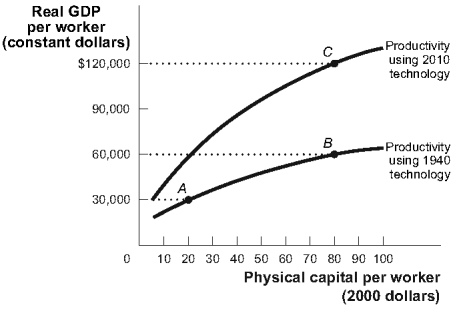Correct Answer

verified
Correct Answer
verified
Multiple Choice
Economists mostly agree that the problem of climate change necessitates government action in the form of market-based incentives such as:
A) tax rebates to those causing negative externalities.
B) a reduction in the amount of gasoline that each person is allowed to purchase.
C) a carbon tax or a cap and trade system.
D) a reduction in the price of green cars and appliances.
Correct Answer

verified
Correct Answer
verified
Multiple Choice
All of the following are reasons average workers in the United States today produce more than their counterparts a century ago EXCEPT that the modern worker:
A) is better educated.
B) has more physical capital to work with.
C) has better technology to work with.
D) works longer hours.
Correct Answer

verified
Correct Answer
verified
Multiple Choice
Which sector is responsible for most of the growth in the United States during the 1990s?
A) service
B) manufacturing
C) mining
D) retail
Correct Answer

verified
Correct Answer
verified
Multiple Choice
Between 1980 and 1994, real per capita GDP in sub-Saharan Africa:
A) fell by 13%.
B) fell by 50%.
C) increased by 10%.
D) increased by 7% per year.
Correct Answer

verified
Correct Answer
verified
Multiple Choice
The standard of living in a country can be best measured by:
A) nominal GDP per capita.
B) real GDP per capita.
C) the productivity growth rate.
D) the business cycles.
Correct Answer

verified
Correct Answer
verified
True/False
If technology improves, then it takes more inputs to produce the same output as the last period.
Correct Answer

verified
Correct Answer
verified
Multiple Choice
According to the convergence hypothesis, differences in GDP per capita among countries tends to narrow over time because countries that start with a _____ real GDP per capita tend to have _____ growth rates.
A) lower; higher
B) lower; lower
C) higher; higher
D) higher; negative
Correct Answer

verified
Correct Answer
verified
Multiple Choice
Use the following to answer questions
Figure: Technological Progress and Productivity Growth  -(Figure: Technological Progress and Productivity Growth) Look at the figure Technological Progress and Productivity Growth. If there is a significant increase in human capital per worker (all other factors remaining unchanged) , it is best indicated by a move from:
-(Figure: Technological Progress and Productivity Growth) Look at the figure Technological Progress and Productivity Growth. If there is a significant increase in human capital per worker (all other factors remaining unchanged) , it is best indicated by a move from:
A) A to B.
B) B to A.
C) C to B.
D) B to C.
Correct Answer

verified
Correct Answer
verified
Multiple Choice
Long-run economic growth has been mostly dependent on:
A) rising productivity.
B) a low unemployment rate.
C) an increase in the population, which eventually leads to an increase in the labor population.
D) countries following the rule of 70.
Correct Answer

verified
Correct Answer
verified
True/False
According to the convergence hypothesis, differences in GDP per capita among countries tend to narrow over time because countries that start with a lower real GDP per capita tend to have higher growth rates.
Correct Answer

verified
Correct Answer
verified
Multiple Choice
Use the following to answer questions Scenario: Growth Rates in Two Countries India is growing at a rate of 9% per year, and its real GDP per capita is about $3,500, while the United States is growing at a rate of 3% per year, and its real GDP per capita is about $47,000. -(Scenario: Growth Rates in Two Countries) Look at the scenario Growth Rates in Two Countries. About how much will U.S. real GDP per capita be in 14 years?
A) $71,000
B) $28,000
C) $112,000
D) $224,000
Correct Answer

verified
Correct Answer
verified
Multiple Choice
Use the following to answer questions Scenario: Productivity The economy has grown by 4% per year over the past 30 years. During the same period the labor force has grown by 1% per year and the quantity of physical capital has grown by 5% per year. Each 1% increase in physical capital per worker is estimated to increase productivity by 0.4%. Assume that human capital has not changed during the past 30 years. -(Scenario: Productivity) Look at the scenario Productivity. How fast has physical capital per worker grown?
A) 5%
B) 4%
C) 3%
D) 2%
Correct Answer

verified
Correct Answer
verified
Multiple Choice
According to the rule of 70, if a country doubles its real GDP per capita every 20 years, that country must be growing at an annual rate of:
A) 2%.
B) 3.5%.
C) 35%.
D) 70%.
Correct Answer

verified
Correct Answer
verified
Multiple Choice
Which of the following CANNOT properly be called a part of infrastructure?
A) power lines
B) roads and bridges
C) human capital
D) seaports
Correct Answer

verified
Correct Answer
verified
Multiple Choice
The aggregate production function measures productivity as:
A) real GDP per worker.
B) nominal GDP per worker.
C) median income per worker.
D) average disposable income.
Correct Answer

verified
Correct Answer
verified
Multiple Choice
Who established the first research and development laboratory?
A) Galileo
B) Thomas Edison
C) Thomas Malthus
D) Franklin Roosevelt
Correct Answer

verified
Correct Answer
verified
Multiple Choice
Economic growth is likely to entail:
A) a reduction in investment.
B) a decrease in the capital stock.
C) higher saving.
D) lower saving.
Correct Answer

verified
Correct Answer
verified
Multiple Choice
Technological progress is advanced through:
A) research and development.
B) government regulation.
C) consumption.
D) infrastructure.
Correct Answer

verified
Correct Answer
verified
Multiple Choice
Conditional convergence suggests that:
A) poorer countries are still catching up to richer countries.
B) poorer countries' GDP may not catch up to those of richer countries without changes in education and infrastructure.
C) poorer countries' growth rates depend on their ties to a richer country.
D) poorer countries' growth rates depend on their birth rates.
Correct Answer

verified
Correct Answer
verified
Showing 261 - 280 of 313
Related Exams